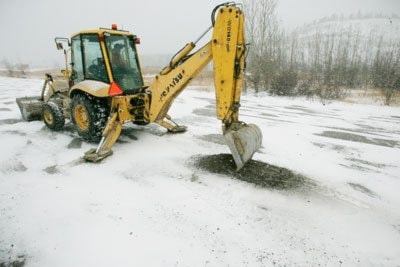A series of bizarre parking-centric bylaws have been written off by city council, clearing the way for Vuntut Gwitchin First Nation development of waterfront land at the intersection of First and Ogilvie.
That is, of course, if the environmental assessment checks out.
The original bylaw “would have resulted in the property being covered mostly in parking lot,” said Stephen Mills, president of the Vuntut Development Corporation.
Official city guidelines described the property as a pedestrian-oriented, thriving area — but the parking requirement pegged it as a big box store area.
“We’re looking for something more dominated by building and landscape than it is by parking lots,” said Mills.
On Monday, city politicians sparred briefly over a subsection requiring 20 metres of landscaped setback between parking areas and the Yukon River reserve.
“If we don’t want to have any parking close to or fronting on the (Yukon River reserve), just say so. Don’t put stupid things like this in here that eliminate it simply because the requirements are so onerous,” said councillor Doug Graham.
Assured a massive slab of asphalt won’t be needed in development plans, workers are now onsite tackling “the next hurdle” of identifying any possible environmental issues with the land.
If contamination is found, the $3.2-million lands would be returned to the Yukon government by early December.
“We have to remember that this purchase in on an as-is basis, so we would adopt any environmental liabilities,” said Mills.
The Ta’an Kwach’an and the Kwanlin Dun are currently in talks about becoming partners in the $20- to $25-million development.
“We’ve had some early discussions with them, we don’t know, in the end, whether they’ll have the appetite to do this,” said Mills.
“People have to get on board or not, that’s where we’re at now,” he said.
At council, a bylaw subsection was also amended giving the Vuntut more flexibility to develop the land. In the past, proposed land uses were conditional, forcing public input sessions and council approval before they moved forward.
Barring the establishment of pet clinics, nonaccessory parking, spectator entertainment and personal service facilities, the developers can proceed with any project they want.
The development, which will eventually encompass six to eight buildings on the waterfront property, is being planned in phases. The goal is to foster a sense of community on the property.
First, they plan a residential development, then office facilities and, finally, retail and service establishments.
“We do really want to see that whole property to be pedestrian, mostly -— people walking there in the evenings, going to coffee shops or some other place to have a meal,” said Mills.
“We just want to see it be a bit more vibrant,” he said.
A smaller parcel of land at the corner of Keish and First will also be part of future development plans.
Within a year, ground could be broken on “phase one;” a mixed-use commercial building located on the waterfront.
